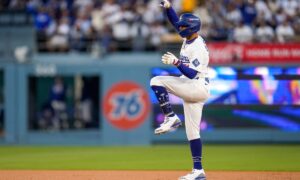In this article we take a deeper look at five must see MLB stadiums across the United States. Let’s dive in.
Dodger Stadium (Los Angeles, California)
Opening in 1962, Dodger Stadium is the largest capacity MLB stadium seating 56,000, 6,000 more fans than the second closest. It has one of the shortest distances to center field (395 feet), making home runs a staple in the ballpark for decades.
Looking out into center field you can see the mountains, and at night time you see the mountain’s silhouette, oftentimes with a beautiful sunset view cascading over the backdrop.
The Dodgers are one of the MLB’s most storied franchises, so you’ll be sitting in a stadium where numerous different events occurred, including Mike Piazza becoming the only player to hit a ball outside the ballpark in 1997.
The stadium also has great views from the upper nosebleed sections, and those are arguably some of the best in the house because of the view you’ll get. Dodger Stadium is one of the most legendary stadiums in MLB history and it’s a must-see for any big baseball fan.
Fenway Park (Boston, Massachusetts)
One of the smallest stadiums in the MLB, Fenway does not disappoint. Despite its lack of size, it is the oldest park in the MLB, opening in 1912. History is everywhere.
Fenway has hosted the World Series on eleven different occasions and has been the setting for many other historic events such as professional football and soccer games, concerts, and political gatherings.
Fenway of course has the “Green Monster”, a large wall in left field which despite what many believe, actually favors right-handed batters because of its short distance from home plate. The wall was originally covered in advertisements until painted green in the ’40s. The inside of the wall is actually covered in former player signatures. Terrace-style seats over the Monster were added early in the 21st century.
There is a lone red seat in the stands which is marked with the farthest home run ever hit in Fenway, though that fact is often disputed by baseball historians. Fenway is legendary day and night and has tons of features baseball fans need to see with their own eyes.
Yankee Stadium (The Bronx, New York)
Yankee Stadium, one of the larger stadiums in baseball, is relatively new, opening in 2009. Alongside 5 other stadiums including 3 others on this list, Yankee stadium is one of 6 stadiums to not have sold its naming rights.
The outside of the stadium is built from limestone which is unique and makes the stadium look older and more retro than it actually is. There is what they call the “Great Hall” with pictures of former Yankee legends hanging from the top. The decoration from the original Yankee Stadium which topped the roof was also replicated.
There is of course the Yankee Museum located in the ballpark which allows fans to look at all the past Yankee glory. The centerpiece of the museum is the “ball wall,” a number of balls autographed by players including the great Babe Ruth. The Yankees are probably the most well-known American sports team, and their new stadium is filled with iconic history.
PNC Park (Pittsburgh, Pennsylvania)
Opening in 2001, PNC Park is located in the center of downtown Pittsburgh along the Allegheny River. A perfect view of the skyline of the downtown area is viewable from behind the home plate and up the right and left baselines.
The giant P in the grass is also unique to other stadiums. PNC Park is actually the first stadium to have other scores from around the league listed around the stadium for fans to watch, making the experience of going to the ballgame more interesting and entertaining. Nowadays, many parks show scores from other games during the duration of their own game.
Speaking of scores, you can follow live MLB scores of every game online on Flashscore.
Back to PNC Park, you can actually see the park on the other side of the river which makes for a cool scene, and the Honus Wagner statue in the front is another must-view feature. The park isn’t one of the most storied, but it’s definitely one of the most beautiful.
Wrigley Field (Chicago, Illinois)
The Friendly Confines as it’s known, located in the neighborhood of Wrigleyville on the north side of the city is the second oldest, and maybe most legendary stadium in all of U.S. sports. Though Wrigley has recently installed lights for night games and a jumbotron, for years it was the only stadium to continue to use the manually operated scoreboard, which is still in use today despite the jumbotron’s presence, and only have the ability to be played in during the day because of the lack of floodlights.
Centerfield has mainly bleacher seats, where you buy a bleacher ticket and it is first-come, first-serve for fans to arrive early to sit closest to the wall.
Perhaps the most legendary feature of Wrigley is the ivy-covered outfield wall. The MLB actually passed a rule that outfield walls must be padded to protect players, except for Wrigley field, who was allowed to keep the Ivy which grows on a cold brick wall.
There are also apartments that overlook the stadium and are called the rooftop seats, where spectators can see the game happening from their rooftop, though nowadays rooftop owners do business with the cubs and sell spots more like tickets. Wrigley is one of the best places to catch a game, and the crowd always makes it a fun environment, hence the Cubs nickname, the Loveable Losers.









